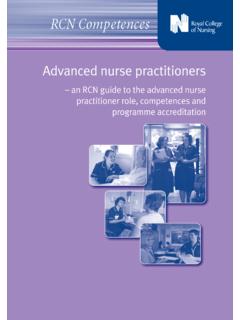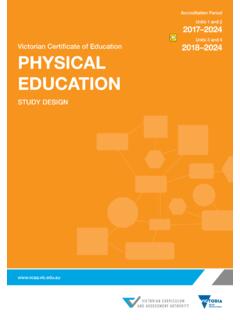Transcription of Practice Profile for Occupational Therapist Assistants (2018)
1 Canadian Association of Occupational TherapistsPractice Profile for Occupational Therapist Assistants (2018)All rights reservedOttawa 2018No part of this publication may be reproduced, stored in a retrieval system or transmitted in any form or by any means, electronic, mechanical, photocopying, recording or otherwise, without prior permission of the Canadian Association of Occupational Therapists. Published byCanadian Association of Occupational Therapists Ottawa, OntarioCanadian Association of Occupational Therapists100-34 Colonnade Road Ottawa, ON K2E 7J6 Tel: (613) 523-2268 or (800) 434-2268E-mail: Canadian Association of Occupational Therapists, 2018 IntroductionThis Practice Profile was first developed in 2007 based on the Profile of Occupational Therapy Practice in Canada (CAOT, 2007d) and previous work related to assistant roles and competence (CAOT, 2007 a, b, c).
2 This updated version of the Practice Profile (2018) ensures the use of the term Occupational Therapist Assistants (OTA), replacing the term support personnel . Advances in national recognition of OTAs and accreditation of OTA educational programs have promoted the acceptance of this term and role. The overall aim for the Profile is that it may be used by: OTAs for career planning; Occupational therapists for appropriate assignment of Occupational therapy service components; Managers and supervisors for performance appraisals; Employers and managers for workforce planning; Employers for assessing qualification requirements for particular Practice settings; Education programs for providing a qualifications recognition process for OTAs; Education programs for providing quality education for OTA; and CAOT for accreditation of OTA education programs in Practice Profile for OTA in Occupational Therapy is herein referred to as the OTA Profile .
3 Please see Appendix A for the Glossary of Key of the Occupational Therapist Assistants Profile (2007)This section describes the development of the original document, Profile for Support Personnel (2007). The key informants were selected by CAOT and the Canadian Occupational and Physical Therapist Assistant Educators Council (COPEC) and included educators at the community college programs for OTA in Occupational therapy with extensive experience in the education of OTA and fieldwork supervisions in numerous Practice areas. This key informant group referenced the previous work of CAOT in the development of this Profile , including: Support Personnel: Conceptual Design and Design Elements (CAOT, 2007a); Development of a Practice Profile for Support Personnel in Occupational Therapy in Canada; Environmental Scan (CAOT, 2007b); Profile of Occupational Therapy in Canada; Occupational Therapists (CAOT, 2007d); CAOT Position Statement on Support Personel in Occupational Therapy (2007c); and CanMEDS 2005 Physician Competency Framework.
4 Better standards. Better physicians. Better care. Ottawa, Ontario: The Royal College of Physicians and Surgeons of Canada( Frank , 2005).Definition of Occupational Therapist AssistantOTA are individuals who have the job-related competencies to support Occupational therapists in delivering Occupational therapy services. The work of the OTA is supervised by an Occupational Therapist (CAOT Position Statement Support Personnel in Occupational Therapy Services, 2007c).Responsibility for Provision of Occupational Therapy ServicesOccupational therapists are the primary service providers for Occupational therapy. Occupational therapists are graduates of accredited university Occupational therapy programs in Canada and have the required skills and knowledge to provide an evidence-based approach to help others identify, engage in and achieve their desired potential in their occupations (CAOT, 2007).
5 Occupational therapy services are provided by an Occupational Therapist . Some components of service may be assigned by the Occupational Therapist to other individuals such as OTAs. All Occupational therapy services must be supervised by a qualified Occupational Therapist . Appropriate supervision is crucial to ensure the quality of client services and is an essential component in the effective management of Occupational therapy service delivery. Please see Appendix B for more details regarding the guidelines for supervision of OTAs. Practice Profile for Occupational Therapist Assistants (2018) 3 Practice Profile for Occupational Therapist Assistants (2018) 4 Features of the Occupational Therapist Assistants ProfileThe OTA Profile follows the structure of the Profile of Occupational Therapy Practice in Canada (2007) which utilizes an adapted role-based CanMEDS model (Frank, 2005).
6 Seven main roles in the continuum of OTA competencies are described, consistent with the Profile of Occupational Therapy Practice in Canada (2007). OTA with focused competencies possess an additional new eighth role of the focused-skill specialist. The eight roles include:1. Expert in Enabling Occupation;2. Communicator;3. Collaborator;4. Practice Manager;5. Change Agent;6. Scholarly Practitioner; 7. Professional; and8. Focused-skill Specialist (competencies for this group are often highly specialized and Practice context specific and therefore not part of the competency Profile developed for OTA Profile underwent extensive validation amongst CAOT members and OTAs in 2007. Celebration of Enabling Occupation as the Core Competency of Occupational Therapist AssistantsConsistent with the Canadian Model of Client-Centred Enablement (Townsend & Polatajko, 2007), expert in enabling occupation is considered the central role, expertise, and competence of OTAs.)
7 Work in this core function is interconnected with all other roles, drawing upon required competencies in order to effectively use occupation as both a medium for action and an outcome for Occupational therapy intervention. Occupational Therapist Assistants Profile FrameworkThe framework of the OTA Profile was designed to accommodate the broad range of Practice contexts of OTA in Canada. The framework acknowledges that a continuum of knowledge, skills and abilities are needed by OTA in Canada to meet the varying requirements of workplace settings. Three exemplar classifications are described within this continuum including support with basic, focused and broad-based competencies. The three exemplars are described as follows:OTA with basic competencies demonstrate selected competencies to service specific populations, Occupational performance issues, and Practice contexts within Occupational therapy Practice .
8 OTAs in this group have typically received training on the job and work in one or two service areas. OTA with focused competencies demonstrate the competencies of an OTA with basic competencies and demonstrate highly developed and complex competencies in a focused area of Practice . Such OTAs have specialized competencies outside of Occupational therapy that are specific to a Practice context and may include skills and knowledge related to such domains as augmentative communication, carpentry, and seating and mobility. Because these competencies fall outside of Occupational therapy they were not developed for inclusion in the key and enabling competencies of the OTA Profile . The competencies of the basic and the focused OTA, other than these specialized technical skills of the focused OTA, are with broad-based competencies demonstrate comprehensive competencies that facilitate providing service with ease and efficiency to various populations (ages/conditions) with a wide range of Occupational performance issues and in a variety of Practice contexts.
9 OTAs in this group have acquired competencies through formal education and training. The examplars describe OTAs who are working at the entry level. For more definitions see Table 1 and Profile for Occupational Therapist Assistants (2018) 5required in any situation are influenced by, and depend on, who the client is ( , individuals, groups, communities, or populations), where the work is being done, and what the client needs. Description of Competency Development as a ContinuumThe OTA Profile articulates a competency continuum that is fluid and dynamic. It describes the skills , knowledge, and abilities of OTA from the basic, focused, and broad-based exemplars. OTAs may enter their career at any point in the OTA continuum and will likely possess skills , knowledge and abilities along varying points of the continuum.
10 Occupational Therapy and OTA Practice Profile ContinuumThe original model, which depicts the role-based Profile of Occupational therapy competencies (CAOT, 2007d), was adapted to include the full continuum of competencies found in both Occupational Therapist and OTA profiles. This adapted model is called the Occupational Therapy and OTA Practice Profile Continuum and represents the competencies that range from the basic exemplar of OTA to the proficient Occupational Therapist . Recognition of the Impact of Practice ContextInvolvement in the seven roles is not equal, as not all roles may be part of everyday Practice . The roles KEY COMPETENCIES for broad-based OTA as EXPERT IN ENABLING OCCUPATION Support with ease and efficiency the Occupational Therapist who is the expert in enabling Demonstrate an understanding of role of Occupational therapists and Demonstrate an understanding of client-centered Practice .









